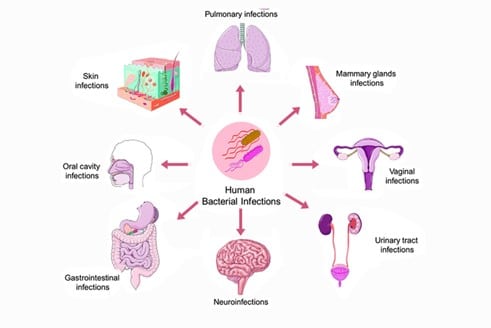Causes, symptoms, treatment, and prevention of bacterial infection
When discussing gut infections, one often hears “good bacteria” and “bad bacteria”. The distinction is necessary, as not all bacteria are harmful. The gut needs good bacteria to digest food and to balance the load of harmful bacteria that can cause infections.
Bacteria are single yet complex cells that do not depend on another organism to survive, whether inside or outside the body. A bacterial infection is caused when a bacterium invades the body. It is common to suffer from a bacterial infection as adults or as children. There are many bacterial infections (gut or gastrointestinal infections being one of them) and ways one can contract a bacterial infection. While many bacterial infections are contagious, the ones contracted through contaminated food, mosquitos or ticks are usually not contagious.
Some infections can cause relatively minor illnesses (such as strep throat, ear infections, and urinary tract infections), some bacterial strains can cause infections that can be potentially life-threatening (such as meningitis and encephalitis). Bacterial infections can affect the throat, lungs, skin, bowel and many other body parts. Some common bacterial infections are Salmonella, Tuberculosis, Chlamydia, Gonorrhea and other sexually transmitted infections (STIs), Strep throat, Whooping cough (pertussis), Urinary tract infections (UTIs), E. coli., Helicobacter Pylori, etc.
Certain disease-causing bacteria are very resilient and tend to be highly virulent, transmissible and can pose a serious risk to public health. Some can even become resistant to multiple antibiotics and lead to expanding host spectra while having the potential for genetic modification because of bioterrorism. Therefore, modern microbiology necessitates studying and researching bacterial strains to better comprehend health and disease.
In this article, Helvetica Health Care (HHC) discusses bacterial infections, their causes, symptoms, treatments and how one can prevent them.
What are the causes of bacterial infections?
Bacteria transmission to humans can happen through air, water, food, or living vectors (arthropods such as mosquitoes, flies, ticks, fleas and lice, etc.) Once bacteria enter the body, they start multiplying and cause a reaction. Bacteria can enter the body through the mouth, nose, or an opening in your skin, such as a surgical wound or a cut, or through your airway.
What are the most common symptoms of a bacterial infection?
Symptoms of bacterial infections vary and depend on the type of infection (gastrointestinal, pulmonary, etc.) and the type of bacteria. However, some of the most general symptoms of bacterial infection are fever, chills, fatigue, swollen lymph nodes in the neck, groin, and armpits, nausea, vomiting, and headaches. Additional symptoms could include:
- redness, ulcers, and pain from skin infections.
- diarrhoea and stomach pain for gastrointestinal tract infections;
- cough, chest pain, shortness of breath and phlegm (sputum) for lung infections;
- neck stiffness, sensitivity to light and confusion for meningitis.
- Low blood pressure, high fever, weakness and sweating in case of septicaemia;
- high fever, night sweats, chest pain, shortness of breath, cough, muscle, and joint pain in case of endocarditis and
- burning sensation or pain when passing urine, frequent urination, discharge from your penis or vagina, and painful intercourse in case of urinary tract infection.
How can you treat bacterial infections?
Certain bacterial infections that last for days or weeks may disappear without medication. Doctors prescribe antibiotics if it is difficult to fight them with the help of the body’s natural defence or immunity system. But, without treatment, some infections tend to spread and cause significant health issues. Untreated bacterial infections may also lead to fatality.
A planned treatment of antibiotics can effectively treat bacterial infections by either killing the bacteria or inhibiting them from multiplying. The entire process assists in building up the body’s immune system to fight the disease. The choice of antibiotic will depend on the type of disease-causing bacteria. Broad-spectrum antibiotics work against a wide range of bacteria.
Based on the severity of the infection, patients may also be given IV medication, besides oral medication, ointments or creams for topical application and eye drops.
To support the treatment of antibiotics, doctors may also prescribe anti-inflammatory or pain medication (such as non-steroidal anti-inflammatories or NSAIDs) for swelling, fever-reducing medication, or cough-reducing medication.
If you have boils, ulcers, or abscesses, you may need surgery. Treating superficial skin abscesses may involve a simple procedure. But treating ulcers deep in the body (in the brain or intestines) will involve extensive surgery.
How can one prevent bacterial infections?
Below are some ways to reduce the chances of contracting a bacterial disease.
- Vaccination: One of the most important technological developments of the contemporary period is vaccination. Active immunisation involves giving the body a low dosage of the bacterium and allowing it to build its own antibodies. Passive immunisation involves giving the body an antibody against a particular disease. Some common vaccines against bacteria are tetanus, whooping cough, diphtheria and bacteria that cause Neisseria meningitides, bloodstream infections, Streptococcus pneumoniae and Haemophilus influenzae type b.
- Good hygiene: Due to the contagious nature of bacterial infections, personal hygiene is imperative. Washing hands, wearing clean clothes, and refraining from sharing personal items with others are ways to prevent transmitting diseases.
- Clean wounds: It is essential to clean and cover wounds or cuts in your skin as bacteria can get into the skin through such breaks.
- Good food habits: Basic food habits go a long way in preventing gastrointestinal infections. These include washing or peeling fruits and vegetables before eating, storing food properly, and cooking meat and poultry until it reaches a temperature that kills bacteria.
- Using contraception for safe sexual practices is a must.
- Protecting oneself from mosquito and bug bites by wearing protective clothing, applying mosquito repellent spray, and maintaining good hygiene for your pets (checking them regularly for ticks) also helps keep diseases at bay.
Some bacteria exhibit inherent resistance to specific antibiotic classes because they lack the drug’s target or are impervious to it. Bacterial strain and culture research is therefore growing exponentially in the medical industry. Bacterial strains resistant to antibiotics have a selective advantage; they can spread throughout the host and even to other hosts. Given the rising antibiotic resistance, bacterial strains selection for tests is becoming increasingly essential for research applications.
To help the research further, HHC supplies a wide range of INACTIVATED and LIVE ORGANISMS. Our collection of bacterial strains is available as PURIFIED DNA (or NATtrol). Most bacteria are clinical isolates, and the identity of the stock culture is confirmed by 16S ribosomal gene sequencing. We continue to expand our collection of new strains of bacteria and products, provided in various formats designed to meet your research and product development needs.
Call us to find the right bacterial strain that meets the requirements of your lab applications.

